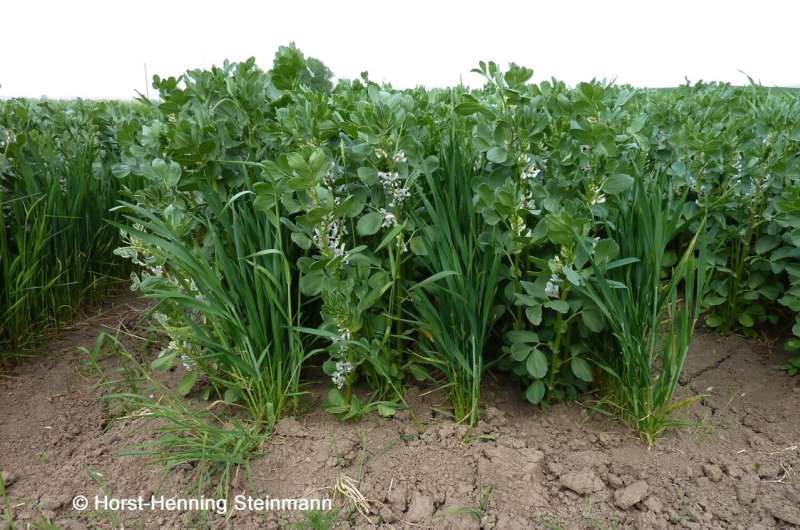Research Results
1. Novel methods identified to boost rice output to meet global food security needs
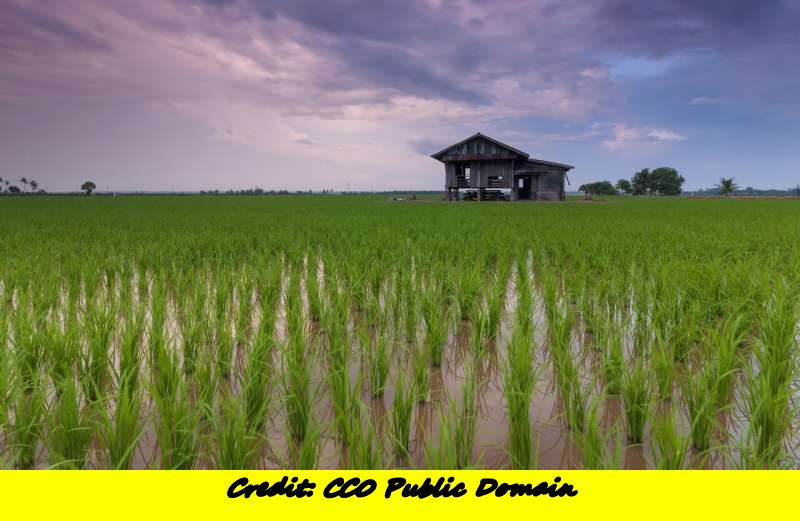
Rice is a staple for more than 3.5 billion people around the world, particularly in Asia, Latin America, and parts of Africa. It has been cultivated in Asia for thousands of years. Recent studies on food security have clearly shown the need for increased and sustainable production of rice, which can be achieved through either conventional breeding or modern methods. Two recent studies have shown promise in this regard.
One way is through genetic engineering, which enables us to grow rice on soils that are prone to seawater inundation, especially from the rise in sea levels due to global warming. Elevated temperatures, along with increasing vapour pressure deficit (VPD), are causing stomatal closure, further reducing plant productivity and cooling. It is unclear what stomatal size (SS) and stomatal density (SD) will best suit all these environmental extremes. Findings by Robert Caine and colleagues from the University of Sheffield, UK, show that genetically engineering rice to reduce the number of stomata can enable such varieties to survive with less water and in places with salt water.
Another way is by synthetic apomixis that has proven feasible in inbred rice through the inactivation of three genes (MiMe), which results in the conversion of meiosis into mitosis in a line ectopically expressing the parthenogenetic trigger in egg cells. An international team of researchers, led by Emmanuel Guiderdoni of Centre de coopération internationale en recherche agronomique pour le développement (CIRAD), France, has shown that synthetic apomixis can be achieved in a rice F1 hybrid by inducing MiMe mutations and BBM1 ovule expression in a single step. They produced hybrid plants that produce more than 95% clone seeds (instead of the usual less than 30%) over several generations. The results show that fully penetrant synthetic apomixes are barrier-free in important crop species, making them suitable for agriculture.
Access the full paper at https://nph.onlinelibrary.wiley.com/doi/10.1111/nph.18704
Also, see https://www.telegraph.co.uk/global-health/climate-and-people/genetic-breakthrough-promises-cheap-crop-costs-worlds-poorest/?mkt_tok=Njg1LU%E2%80%A6%201/6 and https://www.eurekalert.org/news-releases/976213
Access the full paper at https://www.nature.com/articles/s41467-022-35679-3
2. Innovative crop breeding method to meet global demand for grains
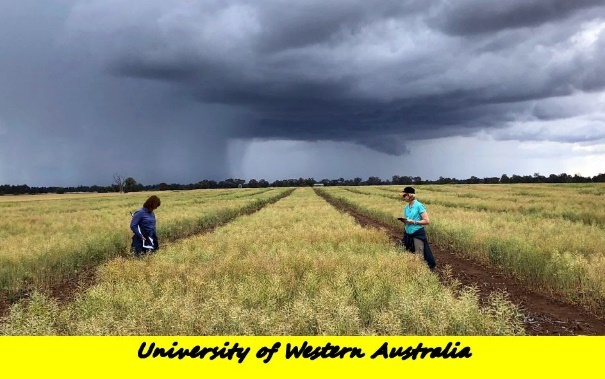 Although many researchers proclaim that the next green revolution is imminent, many of them acknowledge that crop grain yields are stalling due to climate change, while the global demand for grains is expected to double by 2050. Hence, there is a need to look for novel breeding techniques. A plant breeding research team led by Prof. Wallace Andrew Cowling, from the University of Western Australia’s Institute of Agriculture, in collaboration with animal breeding researchers at the University of New England (UNE), have developed a novel crop breeding method that achieved very high rates of genetic gain in canola in Australia and Canada. UWA project manager Professor Cowling said the research had identified a new and innovative method of breeding annual cereal crops.
Although many researchers proclaim that the next green revolution is imminent, many of them acknowledge that crop grain yields are stalling due to climate change, while the global demand for grains is expected to double by 2050. Hence, there is a need to look for novel breeding techniques. A plant breeding research team led by Prof. Wallace Andrew Cowling, from the University of Western Australia’s Institute of Agriculture, in collaboration with animal breeding researchers at the University of New England (UNE), have developed a novel crop breeding method that achieved very high rates of genetic gain in canola in Australia and Canada. UWA project manager Professor Cowling said the research had identified a new and innovative method of breeding annual cereal crops.
Crop breeding must achieve higher rates of genetic gain in grain yield (GY) and yield stability to meet future food demands in a changing climate. Optimal contributions selection (OCS) based on an index of key economic traits should increase the rate of genetic gain while minimising population inbreeding. Researchers applied OCS in a global spring oilseed rape (canola) breeding programme during three cycles of S0,1 family selection in 2016, 2018, and 2020, with several field trials per cycle in Australia and Canada. This method resulted in genetic increases in grain yield of up to 4.3% per year since 2016. Researchers used cutting-edge animal breeding techniques based on optimal input selection to combine rapid cycles of genetic selection in canola. Researchers developed the MateSel software to help animal, tree, and plant breeders optimize the multiple competing goals of their breeding programmes. In addition, one future possibility is the breeding of crops for different global environments and markets in a single programme, using ‘multiple end-uses in MateSel.
For more, see https://www.uwa.edu.au/news/Article/2023/January/Innovative-crop-breeding-method-to-meet-global-demand-for-grains
Access the full paper at https://www.mdpi.com/2223-7747/12/2/383
3. Researchers reveal how geminiviruses cause devastating diseases in worldwide crops
 Genomes of all plant viruses are made of RNA; however, some are not. Geminiviruses are a group of single-stranded circular DNA plant viruses that cause devastating diseases in many economically important crops worldwide, including tomato, tobacco, cotton, maize, wheat, beans, and cassava. A team of researchers, led by Xueping Zhou and Fangfang Li of the Chinese Academy of Agricultural Sciences, Beijing, used a plant DNA virus, tomato yellow leaf curl virus (TYLCCNV) and the related tomato yellow leaf curl virus (TYLLCCNB) as models to investigate the role of the unfolded protein response (UPR)—a conserved response in eukaryote—to alleviate endoplasmic reticulum (ER) stress that is involved in plant growth, development, and response to abiotic and biotic stress in plant DNA virus infection.
Genomes of all plant viruses are made of RNA; however, some are not. Geminiviruses are a group of single-stranded circular DNA plant viruses that cause devastating diseases in many economically important crops worldwide, including tomato, tobacco, cotton, maize, wheat, beans, and cassava. A team of researchers, led by Xueping Zhou and Fangfang Li of the Chinese Academy of Agricultural Sciences, Beijing, used a plant DNA virus, tomato yellow leaf curl virus (TYLCCNV) and the related tomato yellow leaf curl virus (TYLLCCNB) as models to investigate the role of the unfolded protein response (UPR)—a conserved response in eukaryote—to alleviate endoplasmic reticulum (ER) stress that is involved in plant growth, development, and response to abiotic and biotic stress in plant DNA virus infection.
The researchers showed that blocking the UPR response with tauroursodeoxycholic acid or knockdown/deletion of NbbZIP60, an endoplasmic reticulum-localized transcription factor, with the tobacco rattlesnake virus-mediated gene silencing system/CRISPR-cas9-mediated gene deletion system, attenuated TYLCCNV/TYLCCNB infection. The researchers also found that TYLCCNV/TYLCCNB infection or βC1 overexpression could induce nuclear export of YFP-NbbZIP60. The team found that the NbbZIP60-regulated pro-survival factors luminal-binding protein NbBiP and calreticulin NbCRT promote TYLCCNV/TYLCCNB infection, while the NbbZIP60-controlled cell death factor NbNAC089 limits TYLCCNV/TYLCCNB infection. These findings provide new insights into how geminivirus infection activates the UPR and uses the host IRE/bZIP60 pathway in a series of protein-protein interactions to promote virus infection.
Access the abstract at https://link.springer.com/article/10.1007/s11427-022-2196-y
4. A nitrogen-fixing symbiosis-specific pathway required for legume flowering
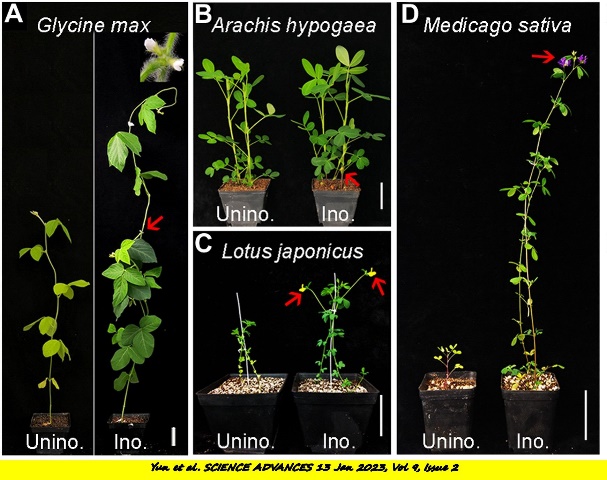
Timely flowering is essential for plants to maximize their reproduction and thus increase their seed production. Five major pathways control flowering in a coordinated manner, and they include endogenous/age, vernalization, photoperiod, gibberellins, and autonomous pathways. Current evidence has revealed that legumes share conserved flowering pathways. Symbiotic nitrogen fixation enhances legume growth and production in nitrogen-poor soils. It has long been assumed that fixed nitrogen increases reproductive success, but the underlying regulatory mechanism was unknown until now.
Jinxia Yun and colleagues at the Huazhong Agricultural University, Wuhan, China, investigated the impact of symbiotic nodulation on the flowering time of legumes and the role of miR172c (a polycistronic oncomir with pleiotropic functions) in inoculated soybean plants. The findings demonstrate that symbiotic nitrogen (N) fixation accelerates flowering in legumes. The researchers found that symbiotically produced miR172c acts as a long-distance signal that travels from nodes to leaves, while nitrogen fixed in nodes induces leaf miR172c. These changes in miR172c increase the total level of miR172, which is necessary and sufficient for plant flowering and legume reproductive success and yield. The combinations of symbiotic miR172c and local miR172c prompted by fixed nitrogen and development in leaves activate florigen-encoding FLOWERING LOCUS T (FT) homologs (GmFT2a/5a) by inhibiting TARGET OF EAT1-like 4a (GmTOE4a). Thus, FTs trigger reproductive development, which allows legumes to survive and reproduce even under nitrogen-deficient soils.
For more, see https://www.science.org/doi/10.1126/sciadv.ade1150
5. Researchers take a step forward in the fight against tar spot of corn
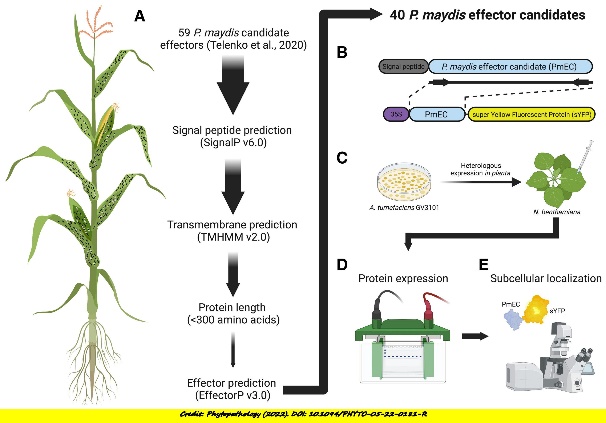
Tar Spot was discovered in the United States of America only seven years ago, but it has wreaked havoc on corn yield—resulting in an estimated 1.2-billion-dollar loss in 2021 alone. The culprit behind this devastating plant disease, Phyllachora maydis, is an emerging fungal pathogen whose biology remains unclear. This lack of understanding significantly limits disease control strategies, and no single corn cultivar is fully resistant to the pathogen. The recent phytopathology study of researchers at the U.S. Department of Agriculture-Agricultural Research Service (USDA-ARS), West Lafayette, led by Matthew Helm, attempted to characterize this pathogen at the molecular level. The data confirm that the tar spot pathogen encodes these virulence molecules and that some localize to specific subcellular compartments of the plant cell, including the nucleus and chloroplasts.
To test the hypothesis that PmECs are targeted to different subcellular compartments, the intracellular locations of PmEC proteins labelled with super yellow fluorescent protein were detected, using a Nicotiana benthamiana-based assay. Helm commented that plant pathologists are only beginning to understand how plant pathogens cause disease at the molecular and genetic levels, especially for newly emerging pathogens. Together, these data indicate that P. maydis candidate effector proteins target different cellular organelles’; they may thus provide valuable information about the putative functions and host processes that this fungal pathogen may influence. This work not only advances our understanding of the biology of this fungal pathogen but also our general understanding of plant-microbe interactions. The study provides a basis for understanding how this plant disease infects corn fields. Further research and improved disease control strategies are needed for the protection of food safety worldwide.
Access the full paper at https://apsjournals.apsnet.org/doi/10.1094/PHYTO-05-22-0181-R
6. New ways to characterize chilli peppers
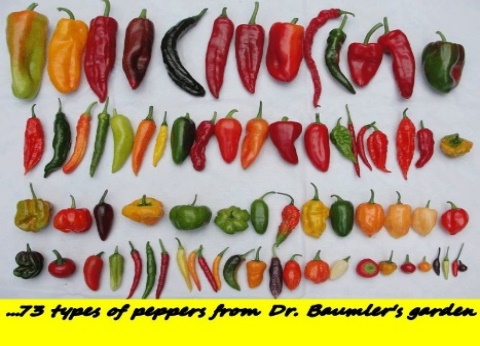 Chile peppers are a major vegetable/spice crop of the world and include several species: Capsicum annuum (includes bell peppers, jalapeños, Thai peppers, etc.), C. frutescens (malagueta, tabasco, etc.), C. chinense (the hottest peppers such as the naga, habanero, etc.), C. pubescens (the South American rocoto), and C. baccatum (includes the South American aji peppers). Traits related to fruit architecture and morphology are some of the determinants of fruit diversity, and they are major contributors to yield and yield potential in chilli pepper. Ehtisham Khokhar and colleagues from the New Mexico State University, Las Cruces, USA, studied 105 genotypes of a Capsicum diversity panel, consisting of cultivars, breeding lines, landrace, and wild species belonging to twelve different pods (fruit) types, for 32 morphometric Tomato Analyzer (TA) descriptors.
Chile peppers are a major vegetable/spice crop of the world and include several species: Capsicum annuum (includes bell peppers, jalapeños, Thai peppers, etc.), C. frutescens (malagueta, tabasco, etc.), C. chinense (the hottest peppers such as the naga, habanero, etc.), C. pubescens (the South American rocoto), and C. baccatum (includes the South American aji peppers). Traits related to fruit architecture and morphology are some of the determinants of fruit diversity, and they are major contributors to yield and yield potential in chilli pepper. Ehtisham Khokhar and colleagues from the New Mexico State University, Las Cruces, USA, studied 105 genotypes of a Capsicum diversity panel, consisting of cultivars, breeding lines, landrace, and wild species belonging to twelve different pods (fruit) types, for 32 morphometric Tomato Analyzer (TA) descriptors.
This study is part of a modernization effort to accelerate the genetic advantage of NMSU’s Chile Pepper Breeding and Genetics Program, using high-throughput phenotyping tools, such as TA. The utility of morphometric TA markers, which are difficult to measure by conventional phenotyping, has been demonstrated. In chilli breeding programs, several cultivars with desired fruit shape and morphology have been recommended as parental lines for hybridization, based on cluster analyses. Results using TA to measure fruit-related traits provide a basis for genome-wide association studies and genomic selection for yield and yield-promoting traits in New Mexico chilli pepper.
Habanero (Capsicum chinense) is appreciated for its aroma and pungency; however, little is known about the stress effects on Habanero fruits, which are becoming increasingly important, owing to climate change. Carlos Rodríguez-López and colleagues from Escuela de Ingeniería y Ciencias, Monterrey, Mexico, using untargeted metabolomics, studied changes in the Habanero fruit pericarp under increased salinity and nitrogen and phosphorus deficiency at three ripening stages. The results point to a threshold in salinity, between 4 and 7 dS·m–1, above which a measurable response is seen. Nitrogen deficiency has a balanced effect on trait enrichment, suggesting metabolite substitution in the pericarp; conversely, phosphorus deficiency leads to a decrease in metabolite diversity, which can negatively affect the post-harvest shelf life. Insight into metabolic adjustments will become more important as climate change intensifies stress on crops, the researchers note.
For more, see https://phys.org/news/2023-01-tomato-software-reveals-phenotypic-diversity.html
Access the full paper at https://journals.ashs.org/hortsci/view/journals/hortsci/57/12/article-p1507.xml
Access the full paper at https://pubs.acs.org/doi/10.1021/acsagscitech.2c00132
7. Impact of historic landscapes and grazing lands in promoting and protecting biodiversity
 There is considerable evidence to indicate that areas that have been historically preserved have promoted biodiversity conservation as well. Using unique historical landscape characterization data for northern England, Michael Stratigos and colleagues from the University of York, UK, show how 18th and 19th century land-use changes in the landscape of a dominant area were protected by area-based conservation measures. Very little is understood about how 18th and 19th century land-use changes affected biodiversity; given the dominance of this type of historic landscape in this part of Britain, these historical changes should form an important area for future research. With the UK Government committed to expanding conservation areas to meet the 30 x 30 target, these results suggest that wider consideration of the nature of the historic landscape would help address some of the entrenched distortions in the UK conservation area network, with positive outcomes for conservation of biodiversity to people living in and near protected areas.
There is considerable evidence to indicate that areas that have been historically preserved have promoted biodiversity conservation as well. Using unique historical landscape characterization data for northern England, Michael Stratigos and colleagues from the University of York, UK, show how 18th and 19th century land-use changes in the landscape of a dominant area were protected by area-based conservation measures. Very little is understood about how 18th and 19th century land-use changes affected biodiversity; given the dominance of this type of historic landscape in this part of Britain, these historical changes should form an important area for future research. With the UK Government committed to expanding conservation areas to meet the 30 x 30 target, these results suggest that wider consideration of the nature of the historic landscape would help address some of the entrenched distortions in the UK conservation area network, with positive outcomes for conservation of biodiversity to people living in and near protected areas.
In many regions, grasslands are maintained over many long years, akin to historical landscapes. A study by Cameron Wagg and colleagues from the University of Zürich, Switzerland, analysed the stability of plant biomass production over two decades in one of the world’s longest-running grassland biodiversity experiments. Since ecosystem stability increases resilience to environmental perturbations, it follows that older, more diverse ecosystems should be especially valued in a changing world. The results show that historic landscapes are useful for addressing conservation priorities and practices related to biodiversity conservation, and they can be particularly useful for understanding the interactions between biodiversity conservation and historic land use, ownership, management, access, and other social influences.
For more, see https://phys.org/news/2023-01-historic-landscapes-biodiversity.html?utm_source=nwletter&utm_medium=email&utm_campaign=daily-nwletter and https://phys.org/news/2023-01-grassland-ecosystems-resilient-age-long-term.html?utm_source=nwletter&utm_medium=email&utm_campaign=da%E2%80%A6%201/3
Access the full paper at https://besjournals.onlinelibrary.wiley.com/doi/full/10.1002/pan3.10424 and https://www.nature.com/articles/s41467-022-35189-2
Potential Crops/Technologies/Concepts
1. Intercropping and mixed cropping provide ecological benefits in addition to grain yield
Given the need for sustainable agricultural production, there has been a revival of interest in adopting the age-old practice of intercropping and/or mixed cropping. Its wider use may provide a key strategy to attain the Sustainable Development Goals of the 2030 Agenda, which seeks to reduce poverty and hunger and deal with climate change while preserving natural resources. These practices, prevalent in the past and still prevalent in many parts of less developed countries, were overshadowed by modern agricultural practices, with an emphasis on monoculture.
Crop diversification methods have been proposed as agroecological solutions to achieve a smaller carbon footprint. Intercropping—the growing of several crop species in the same field—seems to be particularly promising. In recent years, many studies are providing robust evidence for the benefits of intercropping; one such study was undertaken by researchers from China and Netherlands, led by Wopke van der Werf from Wageningen University. The researchers found that although intercropping does not result in dramatic yield increases, overall, the results show that intercropping is well suited to a variety of crops and performs almost as well as the most productive single crop for commodity production. In addition, it improves resilience and ecosystem services and nutrient-use efficiency. This research confirms the interest in intercropping for the development of a more sustainable agricultural production that supports diverse diets. In addition, this research showed that intercropping resulted in mean protein levels that were similar to, and often higher than, those obtained with monocultures.
Agricultural landscapes often have too few flowering plants, which can result in the decline of pollinating insects. Researchers from the University of Göttingen, Germany, led by Felix Kirsch, have investigated how mixing fava beans with wheat affects the abundance of pollinating insects. They found that foraging bees could visit mixed crop areas as often as monocultures, contrary to the expectation that the mixed crops with fewer flowers would be visited less frequently by bees than single crops. The study is the first to link the potential advantages of interaction systems as a foraging environment for bee pollinators compared to leguminous soles with bee foraging behaviour (legal versus illegal visitation), genotypic trait differences, and performance outcomes. Cereal yields can be improved ecologically by adding legumes such as beans or lentils. This can make a valuable contribution to the abundance of flowers in the field and thus prevent the decline of pollinators.
For more, see https://phys.org/news/2023-01-intercropping-sustainable-global-agricultural-production.html?utm_source=nwletter&utm_medium=email&utm_cam%E2%80%A6%201/3 and https://www.anthropocenemagazine.org/2023/01/landmark-analysis-of-132-studies-highlights-the-true-power-of-intercropping-on-farms/?utm_so%E2%80%A6%201/10
Access the abstract at https://www.pnas.org/doi/10.1073/pnas.2201886120
Access the abstract at https://www.sciencedirect.com/science/article/abs/pii/S0167880922004170?via%3Dihub
2. Plant breeding methods using gene editing show promise
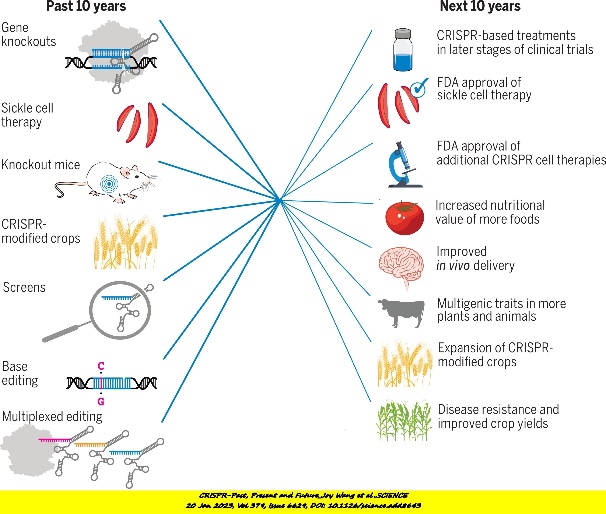 CRISPR gene editing technology has been covered extensively in previous editions of the AgriTech Newsletter. Plant improvement through gene editing, or using gene editing as one of the components of plant breeding, holds considerable promise in several crop improvement programmes worldwide. Here we mention a couple of recent developments and the role they can play in crop improvement efforts.
CRISPR gene editing technology has been covered extensively in previous editions of the AgriTech Newsletter. Plant improvement through gene editing, or using gene editing as one of the components of plant breeding, holds considerable promise in several crop improvement programmes worldwide. Here we mention a couple of recent developments and the role they can play in crop improvement efforts.
Generation of stable gene-edited plant lines using clustered regularly interspaced short palindromic repeats (CRISPR)–CRISPR-associated protein 9 (Cas9) is a lengthy process of outcrossing to eliminate CRISPR–Cas9-associated sequences to produce transgene-free lines. Friedrich Kragler and his team at the Max Planck Institute of Molecular Plant Physiology, Potsdam, Germany, addressed this issue by designing fusions of Cas9 and guide RNA transcripts to tRNA-like sequence motifs that move RNAs from transgenic rootstocks to grafted wild-type shoots (scions) to achieve heritable gene edits, which was demonstrated in wild-type Arabidopsis thaliana and Brassica rapa. The transgenic mobile gene editing system enables the production of transgene-free progeny within one generation without transgene elimination, culture recovery and selection, or the use of viral editing vectors. The authors anticipate that the use of transferable editing systems to produce transgenic plants will apply to a wide range of breeding programmes and crops.
Miscanthus has been added to the number of corps that are improved by using gene editing. Researchers at the DOE Center for Advanced Bioenergy and Bioproducts Innovation (CABBI), the University of Illinois Urbana-Champaign, Urbana, USA, led by Nancy Reichert and Kankshita Swaminathan, have developed gene editing procedures for miscanthus using CRISPR/Cas9, which enabled the mutation of a specific (targeted) endogenous gene to knock out its function. Miscanthus, a C4 member of Poaceae, is a promising perennial crop for bioenergy, renewable bioproducts, and carbon sequestration. The ability to target specific loci to enable endogenous gene editing presents a new avenue for genetic improvement of this important biomass crop.
In the ten years since CRISPR-Cas9 was identified as a genome editing technology, the CRISPR toolbox and its applications have revolutionized basic and applied biological research. Joy Wang and Jennifer Doudna at the University of California, Berkeley, USA, looked at the origins and utility of CRISPR-based genome editing, the advances, and current limitations of the technology, and where innovation and design are needed. The authors describe major advances in the development of CRISPR genome editing technology and make predictions about where the field is headed. Their study also highlights specific examples from medicine and agriculture that show how CRISPR is already impacting society and offers exciting opportunities for the future.
In addition to these developments, some researchers are planning to study the unintended effects of gene editing, for example in tomatoes. Researchers led by Prof Yi Li at the University of Connecticut, Mansfield, USA, are exploring options to help ensure consumers have a safe, abundant, and nutritious food supply. The project is using tomatoes as a model plant and is part of the Biotechnology Risk Assessment Research Grant (BRAG) programme. This promising gene editing technique could improve crops on a large scale. However, the potential unwanted side effects of this process have not been well studied yet, so further research is needed before the technology can be adopted for potential commercial agricultural applications. Tomatoes are among the most popular crops, so they are perfect for the potential improvement of gene editing. In addition, DNA methylation events greatly affect tomato quality and characteristics. Researchers are incorporating the science-based knowledge generated from this project into public education efforts to improve society’s understanding of gene editing technology.
Access the full paper at https://www.nature.com/articles/s41587-022-01585-8
Access the full paper at https://biotechnologyforbiofuels.biomedcentral.com/articles/10.1186/s13068-022-02241-8
3. Saffron cultivation in a protected environment
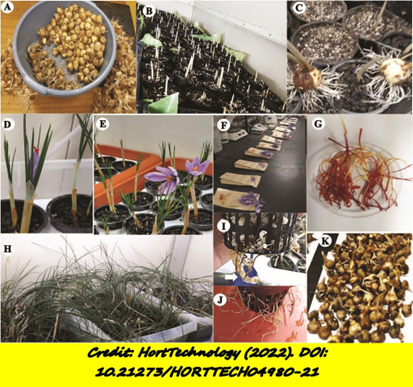 Saffron (Crocus sativus, family Iridaceae) is a geophyte perennial plant, with underground soft corms. It has been cultivated for its high-value stigmas and used as a spice for at least 3,500 years. Conventional cultivation processes are labour-intensive and time-consuming, which results in the high cost of saffron. Several studies have shown that there are very few non-traditional sites where saffron could be successfully cultivated. Hence, researchers have been looking for alternative ways to produce saffron.
Saffron (Crocus sativus, family Iridaceae) is a geophyte perennial plant, with underground soft corms. It has been cultivated for its high-value stigmas and used as a spice for at least 3,500 years. Conventional cultivation processes are labour-intensive and time-consuming, which results in the high cost of saffron. Several studies have shown that there are very few non-traditional sites where saffron could be successfully cultivated. Hence, researchers have been looking for alternative ways to produce saffron.
Yaser Hassan Dewir at King Saud University, Riyadh, Saudi Arabia, and colleagues, in collaboration with Egyptian researchers, were looking at the feasibility of hydroponic cultivation of saffron. They found that saffron plants were vigorous and daughter tuber production in the continuous immersion system was better than it was in the ebb and flow system. The highest stigmas and tuber yields were obtained when mother tubers ≥32 mm in diameter were grown hydroponically in a continuous immersion system. Plants flowered 29 days after planting. Flowering was not affected by growth medium or nutrient supply; however, this was significantly affected by tuber size. Optimized saffron stigma and daughter corms can be achieved in a controlled environment using large corms planted in hydroponics. Researchers conclude that more work is needed on optimizing the growth conditions.
Daniele Bertocchi at GREATIT company of Italy describes a successful hydroponic system of saffron production, growing nine saffron cycles a year with a container farm. The cycle lasted a total of 37 days and can complete nine cycles per year, producing 2 kg of dried stigmas per year. Bertocchi says that it would take about 1000m2 to obtain 2 kg of dried pistils per year in the open field condition. However, getting the same amount of growth containers in multiple layers requires much less area. More importantly, the product quality is outstanding, with fewer risks than in the crop grown in open fields.
Access the full paper at https://journals.ashs.org/horttech/view/journals/horttech/32/2/article-p234.xml
Also, see https://www.hortidaily.com/article/9493576/growing-saffron-in-containers-nine-cycles-per-year/
4. Is ozone effective against Tomato Brown Rugose Fruit Virus (ToBRFV)?
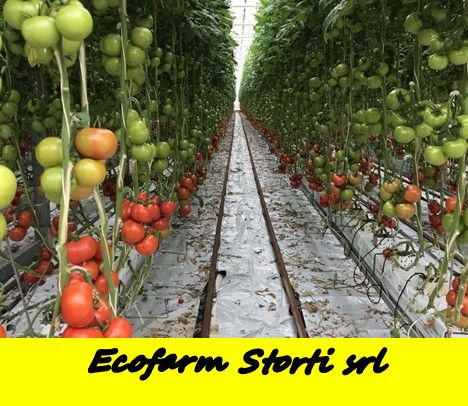 Since its identification in 2015 in the Middle East, much has been done to fight Tomato Brown Rugose Fruit Virus (ToBRFV), but in a few years, its spread has been exponential, demonstrating its virulence and the danger it poses. Indeed, ToBRFV can remain infectious for more than a month on greenhouse surfaces and in cultivation systems. The spread of ToBRFV forces everyone to raise the level of biosecurity necessary in hydroponic cultivation to combat the factor that could lead to a crisis in European tomato production. Ecofarm is an Italian company that has been conducting applied research and installing ozone production systems for years to increase the level of biosecurity in outdoor production systems, combining sustainability, efficiency, and cost-effectiveness. It is sustainable, as ozone needs only oxygen from the air and little energy to synthesize; it is also effective because it helps remove viral, bacterial, and fungal organisms from greenhouses and other production systems; it is economical because it can be automated, consumes little electricity, and does not require the use of consumables.
Since its identification in 2015 in the Middle East, much has been done to fight Tomato Brown Rugose Fruit Virus (ToBRFV), but in a few years, its spread has been exponential, demonstrating its virulence and the danger it poses. Indeed, ToBRFV can remain infectious for more than a month on greenhouse surfaces and in cultivation systems. The spread of ToBRFV forces everyone to raise the level of biosecurity necessary in hydroponic cultivation to combat the factor that could lead to a crisis in European tomato production. Ecofarm is an Italian company that has been conducting applied research and installing ozone production systems for years to increase the level of biosecurity in outdoor production systems, combining sustainability, efficiency, and cost-effectiveness. It is sustainable, as ozone needs only oxygen from the air and little energy to synthesize; it is also effective because it helps remove viral, bacterial, and fungal organisms from greenhouses and other production systems; it is economical because it can be automated, consumes little electricity, and does not require the use of consumables.
A study conducted at the Scientia Terrae laboratories of the St.-Katelijne-Waver research institute showed that Ecofarm’s action plan for ozone treatment of irrigation water is effective in disinfecting ToBRFV-infected wastewater. In addition, for many years Ecofarm has been advising its customers to use ozone for vacuum disinfection of greenhouses before planting, to achieve a true hygienic vacuum and avoid cross-contamination between one crop and another. The results of this great leap in on-farm biosecurity management are now well established, and it can certainly be used to reduce the risk of entry and subsequent spread of ToBRFV and other pathogens, both viral and bacterial, into the greenhouse.
For more, see https://www.hortidaily.com/article/9494630/is-ozone-effective-against-tobrfv/
5. Using biocontrol yeast to curb kiwifruit soft rot
Kiwifruit (Actinidia chinensis) is a widely consumed fruit, with its delicate flavour and high nutrient content. It is susceptible, however, to postharvest diseases during its storage, transportation, and marketing. Soft rot caused by Botryosphaeria 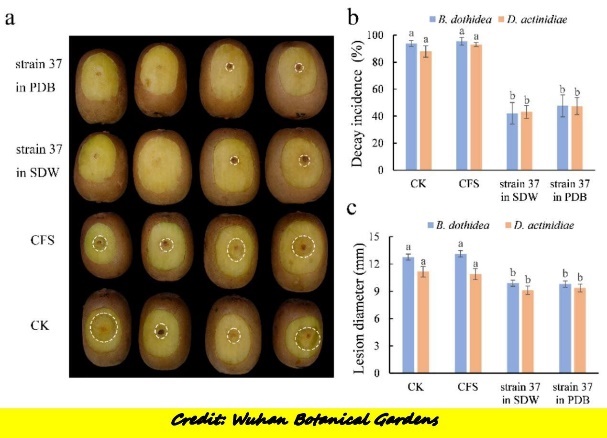 dothidea, Diaporthe sp., Pestalotiopsis microspora, and Alternaria alternata results in substantial postharvest losses. Several studies have shown that biocontrol yeast is effective against blue mold, gray mold, and kiwi black rot. There is limited research on biocontrol yeasts and their potential mechanisms used against postharvest soft rot of kiwifruit caused by Botryosphaeria dothidea and Diaporthe actinidiae.
dothidea, Diaporthe sp., Pestalotiopsis microspora, and Alternaria alternata results in substantial postharvest losses. Several studies have shown that biocontrol yeast is effective against blue mold, gray mold, and kiwi black rot. There is limited research on biocontrol yeasts and their potential mechanisms used against postharvest soft rot of kiwifruit caused by Botryosphaeria dothidea and Diaporthe actinidiae.
Scientists from the Wuhan Botanical Garden of the Chinese Academy of Sciences, led by Li Li, together with colleagues from Huazhong Agricultural University led by Chao-an Long, examined 1113 yeast strains and identified the antagonistic yeast Meyerozyma guilliermondii 37, which can effectively prevent the natural softening of kiwi fruit and greatly reduce the soft rot and natural decay of the fruit According to scientists, M. guilliermondii 37 significantly inhibited pathogen spore germination rate, up to 28.52%, and rot density rate up to 42.11% in artificially inoculated kiwi fruit. Subsequent postharvest soaking treatment of kiwifruit with the biocontrol yeast significantly decreased the incidence of natural decay to 35.69%, while also preserving the quality of softness from natural ripening.
Access the full paper at https://www.mdpi.com/2076-2607/10/11/2143
6. Researchers uncover new potential for ancient mint plants

The mint family of herbs, which includes sage, rosemary, basil, and even woody plants like teak, offers an invigorating jolt to our senses of smell and taste. Michigan State University researchers have found that these plants have diversified their specialized natural characteristics through the evolution of their chemistry. Since 2016, Hamberger has been working on special plant metabolites, called terpenoids, which are important for protecting plants from predators and pathogens. Terpenoids are also common ingredients in environmentally friendly and sustainable agrochemicals and antioxidants, and they are used in cosmetics and fragrances. Hamberger worked with Robin Buell, a former MSU genomics scientist at the University of Georgia, who sequenced several mint plant genomes. Previous research has led to the unique medicinal uses of peppermint. Their research on new molecular adaptations opened the door to future applications of natural plant products of the mint family.
A multidisciplinary approach identified the genomic organization of terpenoid biosynthesis and analyzed the chemical pathways involved. The team found something very unusual in the genome of the bellflower, a member of the mint family. It has a large number of biosynthetic genes. A biosynthetic gene cluster (BGC) is a group of genes that are located close to each other in the genome and participate in the same metabolic pathways. These genes are like individual pearls in a necklace—separate and yet connected. Variants of this BGC have been found in six other species of the mint family. “Our team is excited about the potential of the mint family,” said Hamberger. These mint enzymes, like those found in the American holly plant (Callicarpa americana), allow scientists to make plant-based natural products in the laboratory, including—hopefully in the future—natural, scented mosquito repellents.
Access the full paper at https://www.nature.com/articles/s41467-023-35845-1
News:
1. Biodiversity of the bee population is critical for ecosystems and their loss could jeopardize global production
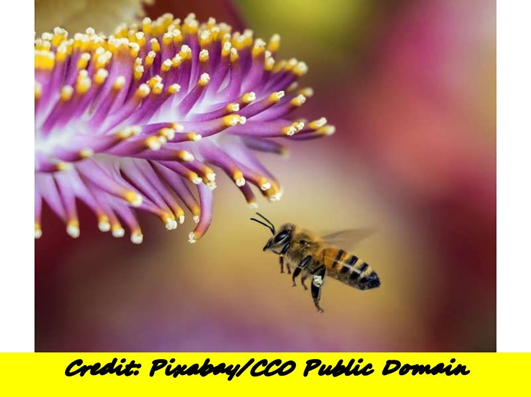 The current biodiversity crisis highlights the need to understand how biodiversity loss affects the functioning of real ecosystems, but the focus usually is on the impact of one component on the other and the overall productivity of a component, for example, crop production. However, biodiversity can be critical to the long-term functioning of an ecosystem when different species are needed to function at different times. A report recently published by Natalie Lemanski and colleagues from Rutgers University, New Brunswick, USA, says that the biodiversity of the bee population is important for maintaining the function of the crop pollination ecosystem, which is essential for food production. Pollinator biodiversity is vitally important for maintaining pollination services over time, and thus for stable agricultural production. Something similar may be true even for bee-pollinated non-agricultural species. Owing to natural fluctuations in bee populations, the researchers say that all bee species are needed to maintain a minimum pollen threshold in lean years. They based their analysis on extensive observations of bees visiting flowers and measuring the number of pollen grains on individual flowers for weeks and months during a given calendar year, and then over many years.
The current biodiversity crisis highlights the need to understand how biodiversity loss affects the functioning of real ecosystems, but the focus usually is on the impact of one component on the other and the overall productivity of a component, for example, crop production. However, biodiversity can be critical to the long-term functioning of an ecosystem when different species are needed to function at different times. A report recently published by Natalie Lemanski and colleagues from Rutgers University, New Brunswick, USA, says that the biodiversity of the bee population is important for maintaining the function of the crop pollination ecosystem, which is essential for food production. Pollinator biodiversity is vitally important for maintaining pollination services over time, and thus for stable agricultural production. Something similar may be true even for bee-pollinated non-agricultural species. Owing to natural fluctuations in bee populations, the researchers say that all bee species are needed to maintain a minimum pollen threshold in lean years. They based their analysis on extensive observations of bees visiting flowers and measuring the number of pollen grains on individual flowers for weeks and months during a given calendar year, and then over many years.
At the same time, bees, especially the domesticated ones, are in trouble. An examination of even healthy honeybees by Elizabeth Capaldi at Bucknell University showed early warning signs of bee stress. Identification of early signs by dissecting the bee brain may help beekeepers to take remedial measures. Bee numbers have been declining for decades, causing headaches and higher costs for farmers who rely on insects to pollinate their apples, almonds, and 130 other fruits, nuts, and vegetables. Experienced beekeepers can often tell when a hive is starting to fail simply by looking at it, which could be due to the fact the bees have not amassed honey, subsisting instead on liquid nectar. Or it could be a lack of a brood. But by that point, it might already be too late. The first sign of insect problems in the USA came to light in the 1980s, when a parasite arrived from overseas. Early warm weather or unusual rain patterns can cause flowers to bloom too early and disappear as insects seek water. Scientists have since identified other protein fragments that may be markers of stress—perhaps because insects change their eating habits in response to infection, which requires more work. After narrowing down the best chemical predictors of bee decline, Bucknell scientists hope to develop an inexpensive rapid test that beekeepers can use.
For more, see https://theprint.in/science/biodiversity-of-bee-population-critical-for-ecosystems-research/1294511/
Access the abstract at https://www.nature.com/articles/s41559-022-01847-3
2. Microalgae could be the future of sustainable superfood in a rapidly changing world, study finds
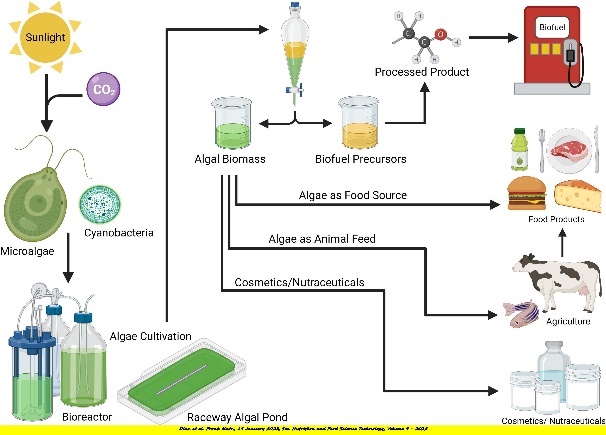 Current agricultural and food production practices are facing extreme stress from climate change and an ever-growing population. The pressure to feed 8 billion people, while ensuring as little environmental impact as possible, has prompted a shift to new, more sustainable foods. Macro (algae and kelp) and micro (single-celled) forms of algae have been used as sources of food. Algae have proven to be a viable source of nutritious biomass that can solve some of today’s food production problems. Researchers from the University of California, San Diego, led by Stephen Mayfield, believe that seaweed could be a new type of superfood, owing to its high protein and nutritional content.
Current agricultural and food production practices are facing extreme stress from climate change and an ever-growing population. The pressure to feed 8 billion people, while ensuring as little environmental impact as possible, has prompted a shift to new, more sustainable foods. Macro (algae and kelp) and micro (single-celled) forms of algae have been used as sources of food. Algae have proven to be a viable source of nutritious biomass that can solve some of today’s food production problems. Researchers from the University of California, San Diego, led by Stephen Mayfield, believe that seaweed could be a new type of superfood, owing to its high protein and nutritional content.
Although algae have long been studied as a source of biofuel because of their high content of lipids or fats, they are also of interest to researchers as they can be a more efficient food source. Although the potential of algae for food has been known for years, now, with climate change, deforestation and eight billion people, there seems to be greater urgency for increased work on algae as nutritious food. Mayfield and colleagues focus on microalgae and cyanobacteria to highlight current advances, which are expanding the range of algae-based foods; they outline the various challenges between current biomass production and large-scale economic algae production for the food market. “The only way to avoid a bleak future is to start the transition. For a newer future, algae as food is one of the transitions we have to make,” Mayfield says.
Access the full paper at https://www.frontiersin.org/articles/10.3389/fnut.2022.1029841/full
3. Fungi could be the future of healthier plants
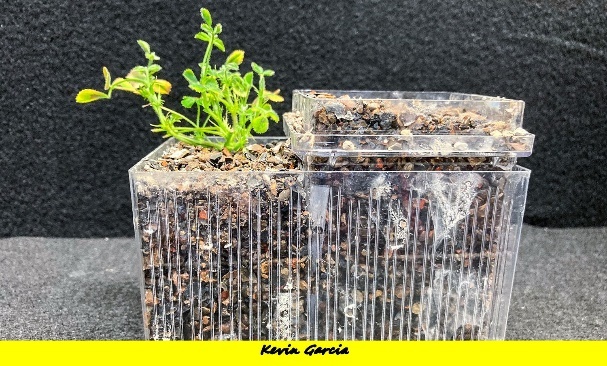 Beneath our feet, there is a vital and living ecosystem. A complex living network underground is made up of roots, nutrients, fungi, and other organisms. Kevin Garcia, in the Department of Plant and Soil Sciences, University of North Carolina, studies how certain fungi can improve this hidden environment and, in turn, preserve the plants we use. Mycorrhizal fungi form a symbiotic relationship with plants. Garcia’s team members are investigating how arbuscular mycorrhizal and ectomycorrhizal fungi help plants obtain nutrients, potassium in particular, an element that North Carolina soils are deficient in. “Instead of creating a chemical environment, we need to create plants that can better interact with their soil microbiological environment. We need to fundamentally understand how plants can obtain these resources. If we can better understand these relationships in the lab, we will better understand the relationships in our agricultural ecosystems,” says Garcia
Beneath our feet, there is a vital and living ecosystem. A complex living network underground is made up of roots, nutrients, fungi, and other organisms. Kevin Garcia, in the Department of Plant and Soil Sciences, University of North Carolina, studies how certain fungi can improve this hidden environment and, in turn, preserve the plants we use. Mycorrhizal fungi form a symbiotic relationship with plants. Garcia’s team members are investigating how arbuscular mycorrhizal and ectomycorrhizal fungi help plants obtain nutrients, potassium in particular, an element that North Carolina soils are deficient in. “Instead of creating a chemical environment, we need to create plants that can better interact with their soil microbiological environment. We need to fundamentally understand how plants can obtain these resources. If we can better understand these relationships in the lab, we will better understand the relationships in our agricultural ecosystems,” says Garcia
Transport systems are critical in many plant processes, including plant-microbe interactions. Nodule formation and its function in legumes involve the expression and regulation of multiple transport proteins, and many are still uncharacterized, especially for the transport of nitrogen. Danielle Cooney is researching ways to improve soybean production by understanding how the crop interacts with soil fungi. For reproductive traits, researchers are looking at yield, plant growth, and plant health—all above-ground factors. Reproduction usually occurs in the most functional, optimistic environment. Underground is so complicated. Mushrooms are generally more useful in nutrient-limited environments. Fungi essentially give plants another set of roots, providing the plant with water and nutrients in exchange for lipids and sugars. Research in Garcia’s lab has shown that the benefits of mycorrhizal fungi to plants are highly context-dependent.
For more, see https://news.ncsu.edu/2023/01/fungi-healthier-plants/
Access a related full paper at https://www.nature.com/articles/s41598-023-28160-8
4. Heat and drought have a ‘significant influence’ on food security and agricultural production, says a new review
Heat and drought are extremely limiting abiotic factors, which pose a major threat to food security and agricultural production. They will be exacerbated by “extreme and rapid” climate change, according to a new paper published by CABI Reviews. A group of international researchers, led by Guillermo Gomer Cotrina Cabello at the Daniel Alcides Carrión National University, Cerro de Pasco, Peru, suggests that understanding the biochemical, ecological, and physiological responses of plants to heat and drought stress is crucial to evolve practical solutions for their management. The comprehensive review describes plant adaptation to heat and drought stress, with particular attention to identifying similarities and variations. Heat and drought stress cause plants to react in many ways, the most important of which is to change their development and morphology. Scientists say that although heat and drought stress can negatively affect the growth and development of plants, reproductive growth is most affected.
As a result of physical damage, biological disturbances, biochemical anomalies, suboptimal water supplies, and unusual temperatures, crop development and yield are adversely affected. However, both stressors have a wide range of effects and are, therefore, difficult to explain mechanistically. A deeper understanding of how plants respond to different challenges can lead to more practical solutions and management. A characteristic feature of the phenomenon is the comparison of basic behaviour with abiotic stresses.
For more, see https://phys.org/news/2023-01-drought-significant-food-agricultural-production.html?utm_source=nwletter&utm_medium=email&utm_campaign=d%E2%80%A6%201/3 and https://www.eurekalert.org/news-releases/976452
Access the full paper at https://www.cabidigitallibrary.org/doi/epdf/10.1079/cabireviews.2023.0004
5. Basmati rice: new authenticity rules aim to remove sub-standard varieties from the market
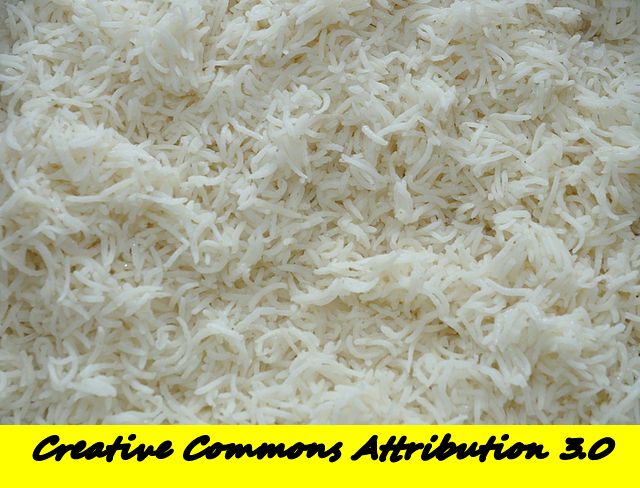 In early 2023, new rules will be introduced in the UK to remove substandard basmati varieties from the market. Fraudsters have become adept at cutting basmati with smaller rice grains, which is because it is up to 50% more expensive per kilo. This followed an explosion of new breeding efforts in the 2000s and 2010s, to overcome the problem with traditional basmati varieties, which are tall, low-yielding, and collapse when fed too much fertilizer.
In early 2023, new rules will be introduced in the UK to remove substandard basmati varieties from the market. Fraudsters have become adept at cutting basmati with smaller rice grains, which is because it is up to 50% more expensive per kilo. This followed an explosion of new breeding efforts in the 2000s and 2010s, to overcome the problem with traditional basmati varieties, which are tall, low-yielding, and collapse when fed too much fertilizer.
The UK Rice Association responded to this finding by publishing a new code of practice that removes six varieties from the whitelist. As a result, consumers will once again be able to buy basmati rice knowing that it is of the best possible quality.
Breeders have begun to focus on crossbreeding, so that basmati varieties can inherit genes, which means they need less fertilizer, are disease resistant, need less or no pesticides, and can even tolerate drier growing conditions or salt-polluted soil. These varieties are not yet completely ready for the market, but they are urgently needed to increase the sustainability of rice production. (Note: India also has set new standards for basmati rice, which will come into effect from 01 Aug 2023: see https://pib.gov.in/PressReleasePage.aspx?PRID=1890710)
Access the new Code for Basmati-UK at https://www.riceassociation.org.uk/_files/ugd/329f2f_9ecdd5484ff94aed9998d506b11e77a5.pdf
6. An opportunity provided by climate change: Soybean production may increase in Europe in the future
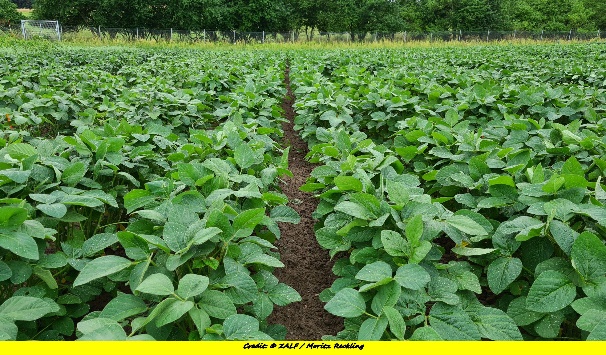 Climate change is making plants grow better in non-traditional regions owing to changes in climate in such regions. That calls for a rethink of crop production toward varieties and crops that are better adapted to heat and drought. The soybean crop thrives in warm conditions and provides itself with requisite nitrogen, and farmers need not provide it via the application of N fertilizer. Researchers at the Leibniz Center for Agricultural Landscape Research, Germany, led by Claas Nendel, demonstrate that in the long term, more and more cultivated land in Europe will become suitable for soybean production. According to the authors of the study, this would enable the EU to do without a large proportion of soybean imports from Brazil and the U.S. in the future (Editor’s note: at the same time, one has to look at the consequences for crops that it might be replacing).
Climate change is making plants grow better in non-traditional regions owing to changes in climate in such regions. That calls for a rethink of crop production toward varieties and crops that are better adapted to heat and drought. The soybean crop thrives in warm conditions and provides itself with requisite nitrogen, and farmers need not provide it via the application of N fertilizer. Researchers at the Leibniz Center for Agricultural Landscape Research, Germany, led by Claas Nendel, demonstrate that in the long term, more and more cultivated land in Europe will become suitable for soybean production. According to the authors of the study, this would enable the EU to do without a large proportion of soybean imports from Brazil and the U.S. in the future (Editor’s note: at the same time, one has to look at the consequences for crops that it might be replacing).
“Expanding soybean cultivation in previously cooler regions expands the possibilities for farmers to make their crop rotations more diverse and thus mitigate the risk of weather-related yield losses and increase biodiversity,” explains Prof. Claas Nendel, head of the study. Under warmer conditions, soybean yields are higher than was previously possible with soy varieties that are adapted to cool temperatures in Germany. Generally, soybeans need a lot of water at the beginning of the season, but dry weather for ripening and harvesting. Although wet harvest conditions and occasional cold weather are the main challenges to expanding soybean production, models and analyses of climate data predict that drought and heat will be the dominant constraints in the future. To improve the adaptation of soybean to changing climatic conditions, it is necessary to breed heat-tolerant and water-saving genotypes.
Access the full paper at https://onlinelibrary.wiley.com/doi/10.1111/gcb.16562
7. Why new GM techniques must be strictly regulated
To counter the UK’s current trajectory, Heike Moldenhauer, Secretary General of the European Non-GMO Industry Association, proposes to maintain the status quo regarding strict regulation of new GMOs. In England, the Genetic Engineering Bill, currently pending in Parliament, is a proposal to exclude new GMOs from all regulations. (Editor’s note: the GE bill of the UK considers gene-edited products as not GMOs and hence safe for human consumption, see Section 2 and Item 2 of this ATN for more on gene editing). In the EU, the use of GMOs is strictly regulated to 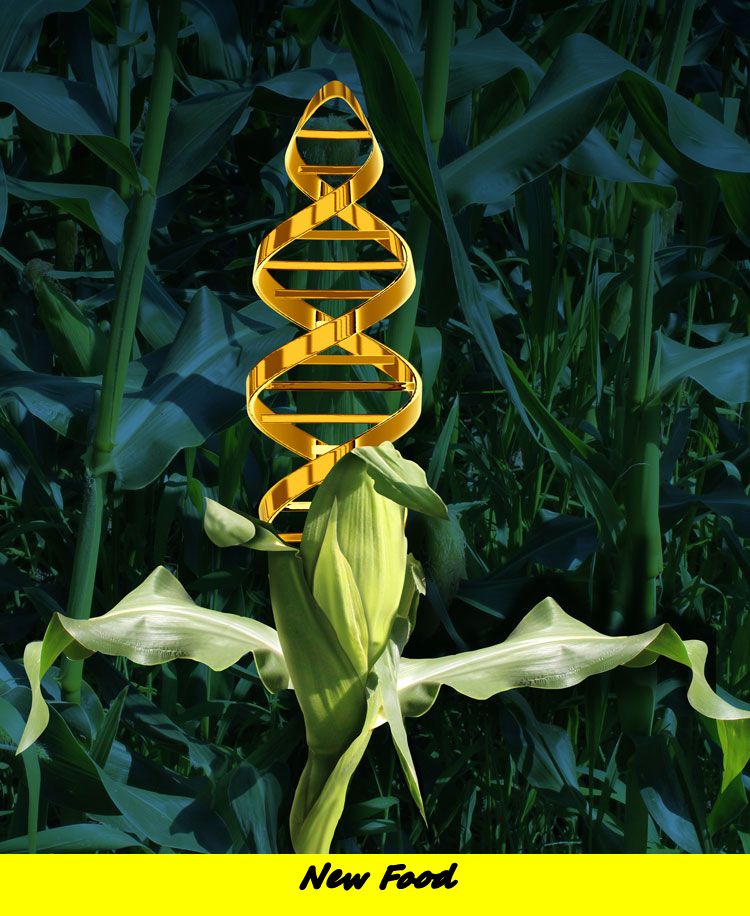 protect human, animal, and environmental health. This legal framework applies to both old and new GMOs—as Europe’s highest court, the Court of the European Communities, legally explained when it ruled in 2018 that all products produced by new methods of genetic engineering are GMOs. The current EU GMO regulations allow GMOs to be accepted and placed on the market, but it also allows them to be avoided. As the EU continues to deregulate planned new GMOs, invisible, untested GMOs will likely reach EU markets, supermarket shelves, and consumers’ plates. (Editor’s note: The EU seems to be wary of gene-edited products as there have been very few studies on the unintended consequences of gene editing. As for intended consequences, see Section 2 and Item 2 of this ATN for more on gene editing and https://www.gefree.org.nz/assets/Uploads/New-GE-unintended-effects-2-1.pdf)
protect human, animal, and environmental health. This legal framework applies to both old and new GMOs—as Europe’s highest court, the Court of the European Communities, legally explained when it ruled in 2018 that all products produced by new methods of genetic engineering are GMOs. The current EU GMO regulations allow GMOs to be accepted and placed on the market, but it also allows them to be avoided. As the EU continues to deregulate planned new GMOs, invisible, untested GMOs will likely reach EU markets, supermarket shelves, and consumers’ plates. (Editor’s note: The EU seems to be wary of gene-edited products as there have been very few studies on the unintended consequences of gene editing. As for intended consequences, see Section 2 and Item 2 of this ATN for more on gene editing and https://www.gefree.org.nz/assets/Uploads/New-GE-unintended-effects-2-1.pdf)
8. Myth: Private breeding can feed the world
 In recent years, there has been much debate on what if the private sector takes over plant breeding, along with seed production and distribution. This has also led to a slight reduction in public sector spending on agricultural research in some countries. However, the public sector continues to play an important role in global plant breeding. Variety development started in the private sector in Western Europe, and the public sector in the region only focuses on breeding research. In the United States, reproduction began in the public sector and many crops are still in Land Grant Universities, and in most developing countries the breeding of the most important food crops takes place mainly in national research institutes, with the support of CGIAR international centres. Private education could be considered the next stage of development.
In recent years, there has been much debate on what if the private sector takes over plant breeding, along with seed production and distribution. This has also led to a slight reduction in public sector spending on agricultural research in some countries. However, the public sector continues to play an important role in global plant breeding. Variety development started in the private sector in Western Europe, and the public sector in the region only focuses on breeding research. In the United States, reproduction began in the public sector and many crops are still in Land Grant Universities, and in most developing countries the breeding of the most important food crops takes place mainly in national research institutes, with the support of CGIAR international centres. Private education could be considered the next stage of development.
Plant breeding without an efficient seed production and distribution system is a rather pointless activity. Breeders in the private sector tend to know customers and farmers better through their sales network; they thus know how to evaluate breeding programmes based on seed sales and can develop a strategic vision of future needs, to ensure that enough good, elite seed is available. However, their work is profit-driven. Their customers are farmers who are willing and able to pay a price for the seed, which includes a premium for breeding and elite seed production. Indeed, they do have much knowledge about various aspects of breeding and reaching farmers, supported by mostly better infrastructure, but it must be noted that the private sector alone cannot provide the right seeds to more than a billion farmers (and myriad crop species).
For more, see
https://seedworld.com/myth-private-breeding-can-feed-the-world/ and https://european-seed.com/2023/01/myth-private-breeding-can-feed-the-world/?__hstc=173990524.6f6c8bde62a22b43093121af16f9263b.1675486256118.1675486256118.1675486256118.1&__hssc=173990524.1.1675486256119&__hsfp=1914029476
9. Game changer: World’s first cow-dung-powered tractor is here
 A British company (New Holland, a producer of agricultural machinery, a division of CNH Industrial ) has created a pioneering tractor that could be a game changer in the green, energy-striving agricultural industry. The ground-breaking cow-dung powered 270 horsepower tractor is said to perform on par with counterparts driven by normal diesel engines, say multiple media reports. According to the company, the methane obtained from cow dung can easily be transformed into fuel, which enables a more circular economic model. The carbon footprint of a farm is an important factor in its sustainability. Farmers still want strong tractors that can run continuously. During the year, pre-production tractor models were tested according to specific requirements.
A British company (New Holland, a producer of agricultural machinery, a division of CNH Industrial ) has created a pioneering tractor that could be a game changer in the green, energy-striving agricultural industry. The ground-breaking cow-dung powered 270 horsepower tractor is said to perform on par with counterparts driven by normal diesel engines, say multiple media reports. According to the company, the methane obtained from cow dung can easily be transformed into fuel, which enables a more circular economic model. The carbon footprint of a farm is an important factor in its sustainability. Farmers still want strong tractors that can run continuously. During the year, pre-production tractor models were tested according to specific requirements.
During a test run on a farm in the county of Cornwall in southwest England, carbon dioxide emissions were reduced from 2,500 tonnes to 500 tonnes in just one year. In a biomethane storage facility on the farm, animal waste from approximately 100 cows was converted into a fuel known as decaying methane. That improved overall farm durability, while more than doubling the range, compared to the CNG design, the company claims.
For more, see https://interestingengineering.com/innovation/worlds-first-cow-dung-powered-tractor
Events: (September 2023)
ICABS 2023: International Conference on Agricultural Biodiversity and Sustainability, 06-07 September 2023, Prague, Czechia

For more, see https://waset.org/agricultural-biodiversity-and-sustainability-conference-in-september-2023-in-prague
ICBDTAA 2023: International Conference on Big Data Technologies for Agricultural Applications 09-10 September 2023, Tokyo, Japan

For more, see https://waset.org/big-data-technologies-for-agricultural-applications-conference-in-september-2023-in-tokyo
ICCACC 2023: International Conference on Conservation Agriculture and Climate Change 16-17 September 2023, Amsterdam, Netherlands

For more, see https://waset.org/conservation-agriculture-and-climate-change-conference-in-september-2023-in-amsterdam
8th Global Food Security Food Safety and Sustainability 16-17 September 2023, Vancouver, Canada

For more, see https://foodsecurity.conferenceseries.com/
ICPCPHT 2023: International Conference on Organic Crop Production and Harvesting Technologies 16-17 September 2023, Rome, Italy

For more, see https://waset.org/organic-crop-production-and-harvesting-technologies-conference-in-september-2023-in-rome
ICPAAB 2023: International Conference on Precision Agriculture and Agricultural Biosecurity 20-21 September 2023, Lisbon, Portugal

For more, see https://waset.org/precision-agriculture-and-agricultural-biosecurity-conference-in-september-2023-in-lisbon
ICARITG 2023: International Conference on Agricultural Research, Innovation, Technology and Globalization 27-28 September 2023, Istanbul, Türkiy

For more, see https://waset.org/agricultural-research-innovation-technology-and-globalization-conference-in-september-2023-in-istanbul
ICEAB 2023: International Conference on Ecological Agriculture and Biodiversity 27-28 September 2023, San Francisco, United States.

For more, see https://waset.org/ecological-agriculture-and-biodiversity-conference-in-september-2023-in-san-francisco
Other Topics of Interest
1.Most species evolve by adapting to similar, large-scale environmental pressures, study finds
2. Nature conservation needs to incorporate the human approach
Access the full paper at https://www.pnas.org/doi/10.1073/pnas.2217303120
3. Farmland bird populations rise with nature-friendly farming
Access the full paper at https://besjournals.onlinelibrary.wiley.com/doi/10.1111/1365-2664.14338
4. Effect of cultivar, cropping on female/male asparagus yields
Access the full paper at https://journals.ashs.org/hortsci/view/journals/hortsci/57/11/article-p1460.xml
5. Viewpoint: Plant-based foods need tighter environmental and regulatory scrutiny
6. The circadian clock controls sunflower blooms, optimizing for pollinators
Access the full paper at https://elifesciences.org/articles/80984nb
7. China approves 8 new GM crops; renews approvals for 2 more
For more, see https://www.isaaa.org/kc/cropbiotechupdate/article/default.asp?ID=19978
8. Study finds flower patterns make bumblebees more efficient
Access the full paper at https://besjournals.onlinelibrary.wiley.com/doi/10.1111/1365-2435.14262
9. How mycorrhizal types control biodiversity effects on productivity For more, see https://phys.org/news/2023-01-mycorrhizal-biodiversity-effects-productivity.html?utm_source=nwletter&utm_medium=email&utm_campaign=daily-%E2%80%A6%201/3
Access the full paper at https://www.science.org/doi/10.1126/sciadv.add4468
10. Study finds link between evolution and herbicide resistance
For more, see https://news.clemson.edu/study-finds-link-between-evolution-and-herbicide-resistance/
Access the full paper at https://nph.onlinelibrary.wiley.com/doi/epdf/10.1111/nph.18655
11. New tomato bred to naturally resist pests and curb disease
12. Ascertaining the most effective silicon fertilization strategy to boost olive tree defences
Access the full paper at https://journals.ashs.org/hortsci/view/journals/hortsci/57/12/article-p1534.xml
13. Just one degree can change a species
For more, see https://onlinelibrary.wiley.com/doi/10.1002/ece3.9471
14. How Gregor Mendel’s discoveries paved the way for modern plant breeding
For more, see https://seedworld.com/how-gregor-mendels-discoveries-paved-the-way-for-modern-plant-breeding/
15. The essence of soil biodiversity
For more, see https://conbio.onlinelibrary.wiley.com/doi/10.1111/conl.12900
16. Peanut skins: More than meets the eye
17. How plants are inspiring new ways to extract value from wastewater
For more, see https://phys.org/news/2023-01-ways-wastewater.html?utm_source=nwletter&utm_medium=email&utm_campaign=daily-nwletter
Access the full paper at (accepted ms) https://nph.onlinelibrary.wiley.com/doi/epdf/10.1111/nph.18762
18. More effective protected areas are needed to halt biodiversity loss For more, see https://www.sciencedaily.com/releases/2023/01/230123123239.htm#
Access the full paper at https://www.sciencedirect.com/science/article/pii/S0006320722004372?via%3Dihub
19. Proper management of nitrogen and irrigation has shown to increase yields and reduce leaching
Access the full paper at https://www.tandfonline.com/doi/full/10.1080/09064710.2022.2122864
20. Plant protection of the future may come from the plants themselves
For more, see https://phys.org/news/2023-01-future.html
Access the full paper at https://journals.asm.org/doi/10.1128/spectrum.01226-22
21. Study reveals seasonal peak photosynthesis hindered by late canopy development in northern ecosystems
Access the abstract at https://www.nature.com/articles/s41477-022-01278-9
22. Unravelling complex traits in wheat: Approaches for analysing genotype × environment interactions in a multi-environment study of falling numbers
Access the full paper at https://acsess.onlinelibrary.wiley.com/doi/full/10.1002/csc2.20133
23. The future of food—CRISPR crops that capture carbon
For more, see https://www.genengnews.com/topics/genome-editing/the-future-of-food-crispr-crops-that-capture-carbon/
24. Black-eyed peas have a complicated history
For more, see https://seedworld.com/black-eyed-peas-have-a-complicated-history/ and https://lab.plant-humanities.org/black_eyed_peas/ and https://daily.jstor.org/plant-of-the-month-black-eyed-pea/ and https://www.loc.gov/everyday-mysteries/agriculture/item/are-black-eyed-peas-really-peas/#:~:text=Cultivated%20since%20pre%2Dhistoric%20times,staple%20of%20the%20slaves’%20diet.
25. Here’s how bioscience is revolutionizing food systems without synthetic chemicals
For more, see https://www.weforum.org/agenda/2023/01/bioscience-agriculture-agtech-davos2023/
26. Microbes could be used by farmers as a natural fertilizer for poor soil
Access the full paper at https://www.nature.com/articles/s41396-022-01345-1
27. Agricultural droughts will continue across water-scarce Central Asia, says study
Access the full paper at https://www.nature.com/articles/s41561-022-01111-0
28. Tanzania’s tomato harvest goes to waste: solar-powered cold storage could be a sustainable solution
For more, see https://theconversation.com/tanzanias-tomato-harvest-goes-to-waste-solar-powered-cold-storage-could-be-a-sustainable-solution-194737 And for information on post-harvest losses, see https://www.aphlis.net/en
29. Groundwater replenishes much faster than scientists previously thought
Access the full paper at https://agupubs.onlinelibrary.wiley.com/doi/10.1029/2022GL099010

